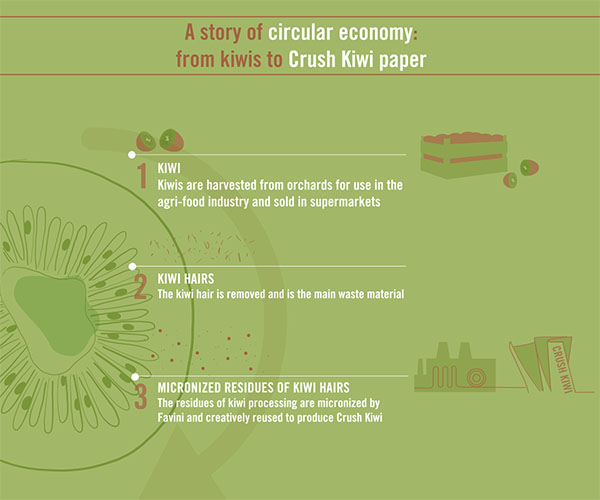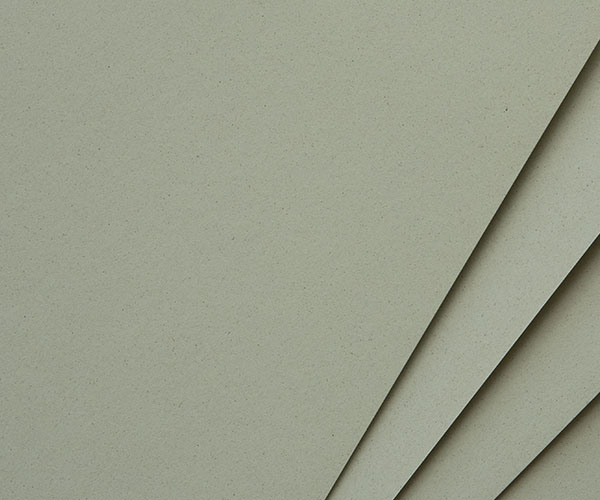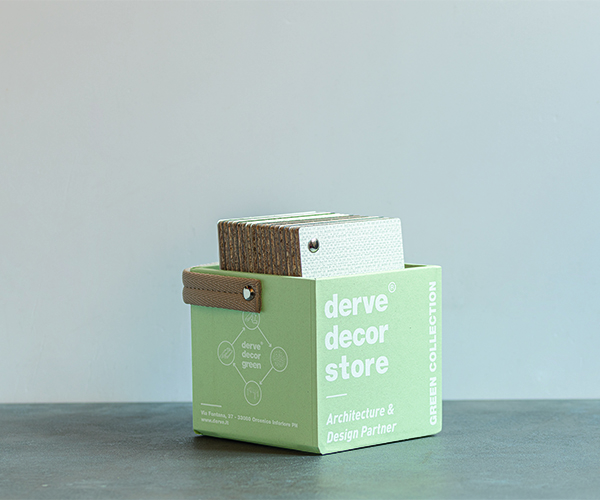In this new chapter of the Crush Story we tell how paper can be produced in a sustainable way thanks to the creative reuse of waste from agri-industrial processes, in particular the residue of kiwi.
Explaining how the residue of this fruit becomes an alternative raw material to produce the ecological paper Crush following a circular economy model.
Italy is one of the world’s leading kiwi producers. According to data published by Alleanza Cooperative Agroalimentari, the production of Italian kiwifruit in 2018 exceeded 400 thousand tonnes, confirming Italy as the top producer of this fruit in Europe and second world producer after China. [1]
This fruit originating from China and once considered as exotic, arrived in Italy in the 70s. It took a short time for numerous orchards to be cultivated in different Italian regions, Romagna, Lazio, Piedmont and Veneto and now kiwi is one of the most widely exported Italian fruits around the world.
The kiwi is used in different ways: eaten as a tasty fruit with many beneficial aspects, used in many dessert recipes, used to produce juices and jams, as well as an ingredient for natural cosmetic preparations.
What is the waste that is generated during kiwi processing? How can these residues become an opportunity for the economy and the environment?
Let’s find out together by retracing the life cycle of the fruit to the ecological paper of Favini Crush Kiwi.
Crush Kiwi: Case history of circular economy, from fruit to an eco-sustainable paper

Kiwi is a fruit originating from China and is where it has been cultivated for over 700 years. In the early 1900s it reached New Zealand, when Isabel Fraser brought it with her back from China in 1904 as a handful of seeds of the Actinidia plant, and then it spread to the rest of the world. Initially known as the “Chinese Grape Thorn”, it was later called kiwi after the national bird of New Zealand. [2]
Before it reaches the fruit and vegetables shelves in supermarkets, the kiwi undergoes a working process during which most of its characteristic hair is removed.
Kiwi hairs are the main waste material for this fruit.
Favini has found a way to recover this residue enhancing it to a premium raw material for the production of high-quality ecological paper Crush Kiwi.
This material is micronized by Favini and added to the cellulose and other ingredients used for paper production. It replaces 15% virgin tree fibre. This is how we obtain a high quality ecological paper following the principles of circular economy.
In addition to the by-products deriving from kiwi processing, here at Favini we also process the residues of corn, cherry, coffee, almond, hazelnut, olive, citrus fruit and lavender.

Crush Story Kiwi continues: The eco-sustainable and recyclable paper for creative applications
The chain that starts with the kiwi orchards does not end with the production of the sustainable paper Crush Kiwi.
This material conceived and produced by Favini by reusing micronized residues of kiwi hair is recyclable within the standard collection for waste paper recycling. The kiwi processing waste takes on new value and seven new lives, which is the number of life cycles that paper and cardboard can have if properly segregated during waste collection and reintroduced into the paper production cycle.
Crush is ideal to create multiple applications that after their use will be recycled. Packaging, catalogues, notebooks, invitations and projects created with the ecological paper Crush will continue their life cycle in successive production cycles according to a circular economy model.


For more inspiration on Crush to produce your own creative projects see Crush’s Pinterest board.
Have you used our ecological Crush paper and would you like to share the result on our social media feed? Contact us at [email protected] with your piece of circular economy history.
Continue to follow the Crush Story:
-
- From citrus fruit to paper
- From bean to Crush Coffee
- From flower to Crush Lavender
- From cherry tree to Crush Cherry paper
- From corn crop to Crush paper
- From vineyards to Crush Grape
- From nut kernels into Crush paper
- From field to Crush Barley
- From olive grove to the ecological paper Crush
- From the bean to Crush Cocoa
- From coconut to paper
Click to find out more about Crush and request the swatch.
[1] universofood.net “Kiwi italiani. I dati 2018”
[2] cinaitalia.com “Il Kiwi: storia, proprietà e utilizzo“


